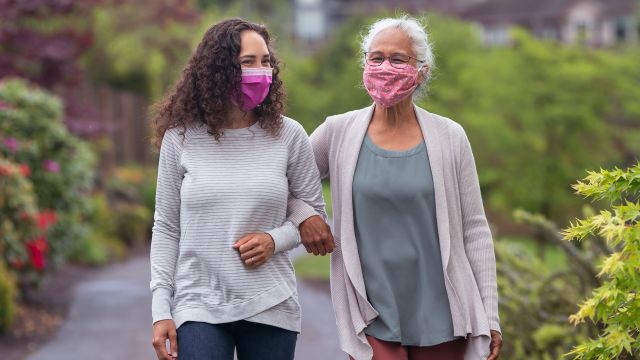Updated on January 10, 2022.
As the pandemic wears on into its third year, expectations for a swift end or the vanquishing of COVID-19 have all but disappeared. Many people are frustrated, confused or skeptical about the vaccines available in the United States and in other parts of the world. Health concerns have also given way to economic fears and worries about mental health, which have infiltrated decision-making. Adherence to rules and health advice may have eroded along with hopes for a return to “normal.”
What many people really want to know is what is going to happen now? When will all this be over—finally? And will the coronavirus that causes COVID-19 ever be something we don’t have to think or worry about anymore?
It’s hard to answer those questions without a crystal ball. But there is a lot more we know now than we did even just a few months ago. Scientists have a pretty good idea of what’s likely to come in the not-too-distant future.
And understanding the role of vaccines and how they are helping to prevent severe disease and slow the spread of the virus on a global scale is critical. No, they’re not a magic bullet and breakthrough infections are happening, particularly given the recent rise of the more contagious variants, namely Omicron. But this doesn’t mean they are not working or that it’s all for nothing.
It won’t end with the flip of a switch
If you’re expecting a splashy headline that proclaims, “It’s Over, Folks,” you may be disappointed, according to Christopher Ohl, MD, a professor of infectious diseases at Wake Forest School of Medicine in Winston-Salem, North Carolina.
“It depends how you define the end,” says Dr. Ohl. Although there will unlikely be a dramatic or abrupt end to the pandemic, Ohl, along with a chorus of other experts, predicts the coronavirus is here to stay.
“I don't think we'll fully eradicate it,” Ohl explains. But, he suggests, the number of cases will eventually fall. “As time goes on, as we get more immunity and as we get more people vaccinated, the numbers of cases will stay more subdued,” he adds. “
The likely scenario: the pandemic eventually ends but SARS-CoV-2 becomes endemic. Like Malaria, it may be constantly present but confined to an area or population, spreading in a predictable way at a predictable rate.
Many experts have long shared this view. In February 2020, Nature published a survey of 119 immunologists, infectious-disease researchers and virologists. Some 89 of those surveyed said the virus will likely become endemic and continue to circulate the world. In this scenario, the coronavirus would cause limited outbreaks in places where most people are immune and much more disease where most people are not.
If this does come to pass as predicted, it won’t be the first time. The virus that causes COVID-19 would be the fifth coronavirus to establish itself permanently among people. There are four other coronaviruses that have been circulating for decades. They are among the seasonal culprits behind common colds.
Each year in the U.S., there are millions of common cold infections. On average, adults get two or three pre year, and many parents can attest, children have even more.
Like those and other viruses, such as the flu, we can—and will—likely learn to peacefully coexist with SARS-CoV-2, according to Ohl.
Although the flu normally contributes to tens of thousands of deaths each year, society meets that virus with annual vaccines, testing and treatment. The same mix of measures may become the norm with COVID, including Pfizer’s antiviral COVID pill and monoclonal antibodies.
“So, it's not going to be a horrible world. It's not like we're going to be living with this ‘Creature from the Black Lagoon’ forever,” Ohl says, noting that one day we may reach the point where the coronavirus isn’t an everyday topic of discussion.
Is herd immunity even a possibility anymore?
The ideal situation, a much-discussed outcome since the pandemic began, is herd immunity.
Also called population immunity or community immunity, herd immunity refers to a specific proportion of people who are immune to an infectious disease.
Herd immunity is achieved once enough people survive infection and/or get vaccinated, making the spread of the disease unlikely—at least for a certain period of time, depending on how long immunity lasts.
Herd immunity can even help protect those who are not immune, such as newborns, because the disease is halted in its tracks before spreading.
Think of it as a two-mile mud run, Ohl explains. “The more herd immunity you have, the thicker the mud gets, and the harder it is for the virus to get through it. [Herd immunity] will either slow it down significantly or stop it before it gets to the other side.”
Thanks to vaccines, we already have herd immunity to measles, mumps, polio and chickenpox, according to Johns Hopkins University public-health experts Gypsyamber D’Souza and David Dowdy. That said, outbreaks can still occur in areas where the population has lower vaccine coverage. These outbreaks can put people whose immunity has faded over time at risk. This is possible with both natural and vaccine-acquired protection.
Exactly what percentage of a population needs to be COVID-immune to achieve herd immunity is still unclear. The number depends on many factors that are still hard to pin down, including the efficacy of the vaccine among unmasked people and how long protection lasts.
Reaching herd immunity is likely to be a steep challenge. COVID-19 is a highly contagious disease. An extensive artificial intelligence (AI) model validated by experimental results on the coronavirus estimates that the Omicron variant, which now accounts for nearly all new cases in the U.S., is 2.8 times as infectious as Delta and about ten times more contagious than the original COVID strain. The easier it is for a virus to spread, the higher the threshold for herd immunity.
Complicating matters, developing countries won’t be able to access enough vaccines to cover their populations. In some other areas, people will continue to refuse vaccines. And additional mutations could continue to slow recovery and play a role in keeping infections going—at least in the short-term.
This doesn’t mean the vaccines are useless or unnecessary
The initial purpose of COVID vaccines has always been to prevent severe disease and save lives. Phase 3 trials for the Pfizer, Moderna, and J&J vaccines only looked at protection against symptomatic COVID. They did not look at how well these vaccines protect against spread among infections that do not cause symptoms. The fact that they helped prevent spread at all was a bonus or icing on the cake.
Data compiled over the past two years is clear: the COVID vaccines help keep people alive and out of the hospital. Researchers estimate that in the U.S. alone, they’ve saved 279,000 lives.
The vaccines are also helping to slow the spread of the disease, helping to ease the burden on an overwhelmed healthcare system and avoid closures and shutdowns. They also help reduce the odds that more variants will emerge.
“Pockets of infection” will likely remain
COVID outbreaks may continue to occur around the world, much as they still do with measles, Ohl says. A largely immune population should help stop these pockets from widening too far. But, he adds, “that's why we talk about global disease security and trying to lift all boats of the world at the same time because it's the best way for us all to be protected.”
For all those reasons, masking, social distancing and handwashing will continue to be important—at least for a while.
In a January 2021 statement from the United Nations, Obiora Okafor, an independent expert on human rights and international solidarity, said that inequitable global distribution of the vaccine—with wealthy countries inoculating their residents sooner than poorer nations—will stall the pandemic’s end.
That’s because if only wealthy countries are vaccinated, the virus will continue to circulate in poorer ones, potentially evolving ways to resist immunity.
Okafor concluded, “This pandemic will not end for anyone, until it ends for everyone.”





